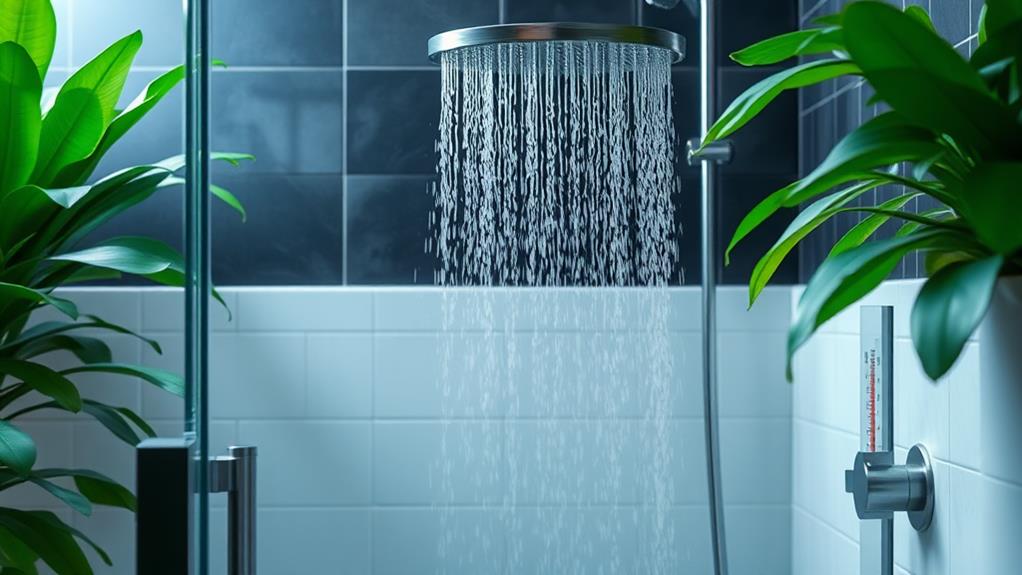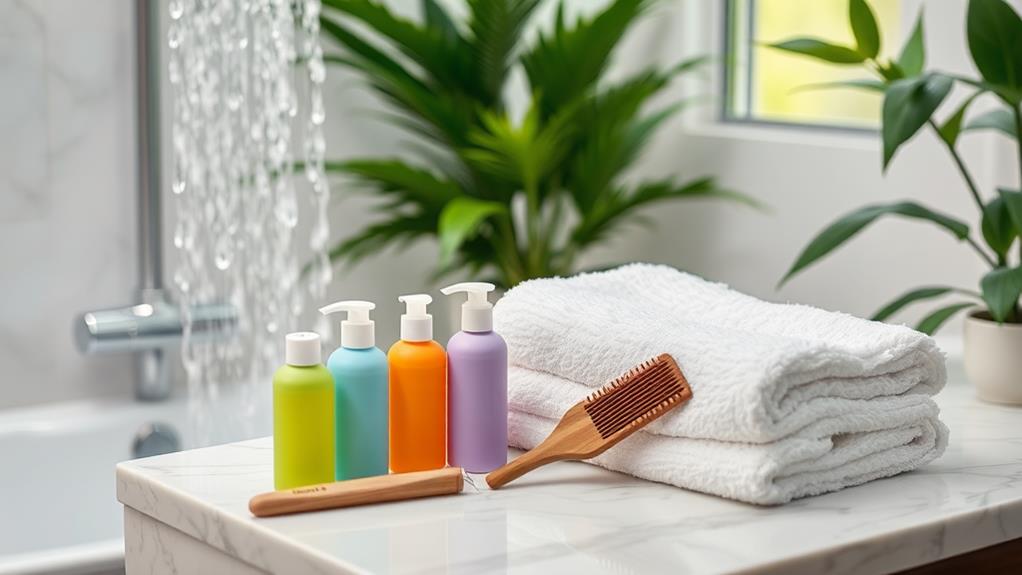When you step into the shower, it's easy to overlook how your routine affects your hair's health. You might not realize that the water temperature you choose can make a significant difference, or that the way you brush your hair beforehand matters more than you think. By implementing a few simple techniques, you can enhance your hair's robustness with every wash. Curious about the best practices that can transform your shower experience and elevate your hair care game? Let's explore some fundamental tips that could make all the difference.
Optimal Water Temperature

When it comes to hair care, the right water temperature makes a significant difference. You may not realize it, but using lukewarm water—just above body temperature—is key for keeping your hair healthy. This ideal water temperature helps prevent stripping away the natural oils your hair and scalp need. If you use hot water, you could end up with dry, damaged hair and an irritated scalp.
By rinsing with lukewarm water, you activate your shampoo and conditioner more effectively without causing harm. It's especially important to remember this when choosing products for different hair types. For instance, if you have oily hair, lukewarm water can help remove excess oil without over-drying. On the other hand, dry or curly hair often benefits from this temperature as it helps retain moisture.
Want to take it a step further? Consider steaming your hair before shampooing. Wrapping your hair in a hot, damp towel for about 20 minutes can help unclog scalp pores, leading to improved scalp health.
If you struggle to maintain the right water temperature, smart shower heads are available that track it for you. Some even offer mobile notifications to remind you to adjust it during your shower routine.
Effective Brushing Techniques
When it comes to effective brushing techniques, starting off right can make all the difference for your hair.
Always detangle before showering using a wide-tooth comb, as this helps prevent breakage.
Detangle Before Showering
Detangling your hair before showering can greatly reduce breakage and damage. Wet hair is more elastic, which makes it prone to snapping when you try to comb through knots. To keep your hair healthy, start by gently detangling when it's damp, not fully wet. This way, you can prevent breakage and keep your strands intact.
If you have straight hair, reach for a wide-tooth comb or a plastic vent brush. Begin at the ends, working your way up to the roots. This technique minimizes stress on your hair and helps prevent knots.
For those with curly hair, it's best to detangle after applying conditioner. The conditioner adds slip, making it easier to comb through without causing friction.
Regularly detangling your hair can promote healthier hair by preventing those pesky knots and tangles that lead to split ends. Plus, it makes your hair more manageable, so you can rock that gorgeous style with confidence!
Use Wide-Tooth Combs
Using a wide-tooth comb is one of the best ways to care for your hair while showering. These combs are perfect for detangling damp hair without increasing the risk of hair breakage. When your hair is wet, it's more vulnerable, so using a wide-tooth comb helps guarantee safe detangling and reduces the chances of damage.
Start detangling from the ends of your hair and work your way up. This technique helps minimize stress on your strands and prevents further tangling. If you have curly hair, it's especially important to detangle post-conditioning. The conditioner provides slip, making it easier to glide the wide-tooth comb through your curls while maintaining their integrity.
Regularly detangling your hair not only helps prevent knots but also reduces split ends, which can lead to breakage over time.
Avoid using fine-tooth combs or brushes on wet hair, as they can create more damage. Instead, embrace the wide-tooth comb to keep your hair healthy, smooth, and manageable.
With these simple techniques, you'll be on your way to beautiful, healthy hair that's ready to shine!
Brush When Dry
Brushing your hair dry is essential for maintaining its health and energy. When your hair is wet, it's more prone to breakage, so it's best to wait until it's almost dry before you brush your hair. This way, you minimize damage and keep those pesky split ends at bay.
If you've just washed your hair, use a wide-tooth comb for detangling instead of a regular brush, especially on wet hair. Start from the ends and work your way up to lessen stress on the strands, preventing breakage.
For those with curly hair, be extra gentle while brushing. It's often best to detangle after applying conditioner, using that same wide-tooth comb.
Slow and gentle combing promotes a healthy scalp and nourishes hair follicles, which enhances overall hair health. Remember, a little patience goes a long way!
Pre-Cleansing Hair Care

Before you jump in the shower, taking a moment for pre-cleansing hair care can make a big difference.
Rinsing off any excess hair products helps keep your skin clear and sets the stage for effective shampooing.
Plus, using oils or masks before you wash can nourish your hair, ensuring it looks its best throughout the day.
Importance of Pre-Cleansing
Often overlooked, pre-cleansing hair care plays an essential role in maintaining a healthy scalp and vibrant hair. Before you engage in your shower routine, consider rinsing your hair to remove excess hair products. This simple step helps prevent buildup that can clog your scalp, ensuring better scalp health.
You want your hair to shine, so don't let leftover products interfere with your body wash either!
Incorporating a nourishing hair mask or oil treatment before shampooing can work wonders. These treatments not only nourish your hair but also enhance moisture retention during the washing process.
Rinse Excess Products
Start your shower with a quick rinse to wash away excess hair products that can weigh your hair down and irritate your scalp. Using lukewarm water, spend about a minute rinsing your scalp and hair. This simple pre-cleansing step helps loosen and remove product buildup from styling products, oils, and serums, making it easier for your shampoo to do its job.
By rinsing excess products first, you create a clean slate for your hair care routine. Not only does this help your shampoo lather better, but it also guarantees your scalp and hair are truly clean. If you skip this step, you may end up with clogged pores, leading to body acne and irritation.
A thorough rinse supports healthy hair and enhances the effectiveness of your hair care products. Remember that the right water temperature matters too; lukewarm water is gentle and helps open your hair cuticles, allowing for better cleansing.
Incorporating this pre-cleansing rinse into your routine will set you up for success, making your hair care regimen more effective and enjoyable. So, rinse away those excess products and step into a healthier hair journey!
Sequence of Hair Care
Establishing a solid sequence for your hair care routine can make all the difference in achieving healthy, vibrant locks.
Start by prioritizing your pre-cleansing treatments. Apply a nourishing hair mask or pre-shampoo treatment to allow the ingredients to absorb fully before you jump into the shower. This extra time enhances the effectiveness of these products, giving your hair a much-needed boost.
Before you wash your hair, rinse excess hair products out thoroughly. This step's essential for clearing away any buildup that could clog your pores and potentially lead to skin issues.
Once you've done that, it's time to cleanse your hair. Use a gentle shampoo to wash away dirt and oils, and don't forget to follow up by applying conditioner to hydrate and protect your strands.
Proper Shampooing Methods
When it comes to shampooing, the right technique can make all the difference in maintaining healthy hair. Start your shower by rinsing your hair with lukewarm water for about one minute. This helps activate the shampoo lather while guaranteeing you don't strip your scalp of its natural oils.
Once you're ready to shampoo, use a quarter-sized amount and distribute it evenly, focusing primarily on your scalp. This area tends to hold the most dirt and oil, so giving it some extra attention is key.
As you massage your scalp gently for 30-60 seconds, you'll promote circulation and guarantee thorough cleansing. Remember, avoid applying shampoo directly to the ends of your hair; this can lead to dryness and damage. Instead, let the suds naturally flow down to cleanse the lengths as you rinse.
To keep your hair looking its best, limit shampooing to 2-3 times per week. Over-washing can leave your strands dull and lifeless, as it disrupts the natural oil balance.
Additionally, consider using sulfate-free shampoos, which are gentler on your scalp and help maintain moisture. Traditional sulfates can strip away essential oils, leading to dryness and irritation.
Incorporating these proper shampooing methods into your hair care routine can help you achieve healthy, vibrant hair while keeping your scalp balanced and nourished. Happy shampooing!
Essential Conditioning Tips

Conditioning is an essential step in your hair care routine that can greatly enhance the health and appearance of your locks. To get the most out of your conditioner, apply it primarily to the middle and ends of your hair. These areas crave hydration, while your scalp doesn't need the extra moisture, which can lead to buildup and clogged pores.
Before you reach for that conditioner, towel dry your hair gently. This simple step helps reduce frizz and allows the product to penetrate better, giving your hair the nourishment it needs. When you apply the conditioner, take your time to focus on the lengths rather than the roots. This way, you avoid overwhelming your hair with excess oils and guarantee that it gets the moisture it craves.
Another key tip is to choose a conditioner based on your specific hair type. For instance, if you've got thick curls, you'll likely need a richer formula for added moisture. On the other hand, straight or fine hair types may do better with lighter conditioners.
Don't forget about leave-in time! Limit how long you let the conditioner sit in your hair; its active ingredients work best when your hair cuticle is open.
Post-Shower Care Practices
After showering, it's important to adopt effective post-care practices to keep your hair healthy and vibrant.
Start by gently squeezing excess water from your hair using a microfiber towel. This helps reduce friction and minimizes breakage, which is vital for maintaining your hair's strength. Instead of wrapping a regular towel around your head, opt for a microfiber one, as it's gentler on your strands.
Once you've removed some of the water, it's time to apply leave-in conditioner or hair oil on your damp hair. Focus on the mid-shaft to the ends, where moisture is often needed the most. This step locks in hydration and enhances shine, giving your hair that healthy glow we all desire.
Next, remember to avoid brushing wet hair, as it's more prone to damage. Instead, use a wide-tooth comb to gently detangle your locks, starting from the ends and working your way up. This method helps prevent breakage and keeps your hair looking its best.
Whenever possible, allow your hair to air dry. Heat styling can lead to dryness and brittleness over time, so embracing your natural texture is a great choice.
If you do need to use heat styling tools, don't forget to spritz on a heat protectant spray first. This extra layer of protection guarantees your hair stays healthy, shiny, and vibrant.

